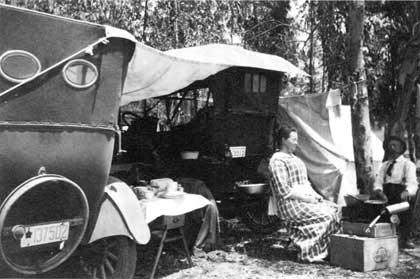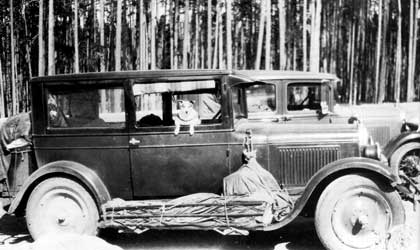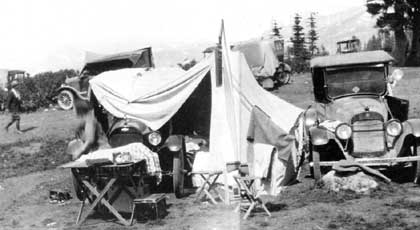Save the Auto Camps!
by Stephen Mark
In the mid-1800s. roads and water routes were the two ways of transporting goods and travelers during the Euro-American settlement of the Pacific Northwest. Hotels, in the modern sense of the word, developed as the accompaniment to the convenient transportation systems represented by the railroads. As the number of cars increased in the Pacific Northwest after 1905, so, too, did the need for accommodations for auto enthusiasts. The first half of this century saw the rise and fall of auto camps. Today, lacking protection from the National Register of Historic Places, these historic sites are rapidly disappearing.
|
Some automobile owners viewed themselves as pioneers and reveled in their ability to camp on the outskirts of towns or anywhere along a road. ca 1927, Courtesy Southern Oregon Historical Society #15051 |
The auto camping fad peaked between 1915 and 1922. Spurred, in part, by the fear of breaking down on poor roads, possibly miles from any town with a hotel, travelers began outfitting their vehicles with camping equipment. Some automobile owners viewed themselves as pioneers and reveled in their ability to camp on the outskirts of towns, or anywhere along the road. Camping was also inexpensive, and many vacation destinations offered no other type of accommodation.
The early auto campers often avoided hotels, even though most could easily afford the rates. By camping, the auto “gypsy” did not have to make reservations, or eat at the times set by the hotel dining rooms. He did not have to tip, nor explain his sometimes disheveled appearance after a day on the road to a clerk in a hotel lobby. In camping there was room for a tourist’s family, easy access to his vehicle (most hotels did not have their own parking until after World War II), informality, and fresh air. [1]
Even before the Pacific Highway opened in 1913 as a route connecting cities located in the region’s western interior valleys, auto camping had been done on a short-term basis in many towns. Campers in Ashland were allowed to occupy the city park for a couple of weeks each summer for the Chautauqua festivities. By 1910, auto campers were the natural successors to the earlier attendees brought to town by wagon. [2]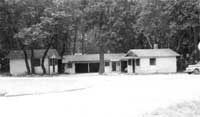 Lithia Park Auto Court ca 1940
Lithia Park Auto Court ca 1940
Courtesy Southern Oregon Historical Society #15988
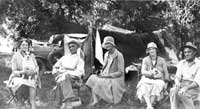 Left to right: Minnie Lane, Mr. and Mrs. Pernell Whitmore, Jessie Stone and Clarence lane at Diamond Lake. Their two pets are Patsy Ruth and Skippy Stone. June 1931, Courtesy Southern Oregon Historical Society #15035
Left to right: Minnie Lane, Mr. and Mrs. Pernell Whitmore, Jessie Stone and Clarence lane at Diamond Lake. Their two pets are Patsy Ruth and Skippy Stone. June 1931, Courtesy Southern Oregon Historical Society #15035
Problems associated with unrestricted camping justified the establishment and subsidization of free municipal auto camps. The first official municipal camp in the United States appeared in Douglas, Arizona. in 1913. [3]
Within two years, several cities in the Pacific Northwest wanted to cash in on the number of affluent auto tourists passing through their communities. Boosters looked to the town’s park board to situate an auto camp in a centrally located city park. They reasoned that this would attract tourists to downtown stores and allow the town to advertise itself as one which embraced progress. [4]
Grants Pass and Ashland preceded larger cities in the region by opening municipal auto camps in 1915. Grants Pass was first to open its auto camp. The city made use of Riverside Park, an area opened in 1910, to provide public access to the Rogue River. A park fund was initiated in 1914 so that an automobile entrance and an adjoining campground could be constructed. The latter was built in 1915:
… on the river bank east of the park and all camp conveniences were provided to make the stop of this class of tourists in Grants Pass as pleasant as possible. The town, already a popular stopping place for train passengers and auto tourists who stayed in hotels, needed the campgrounds to provide for those who carried camping equipment and did not stay in the hotels. [5]
|
Tents were rolled up and placed below the door to keep more room inside the cars for camping equipment, clothes, people and pets. July 1930; Courtesy Southern Oregon Historical Society |
Ashland began construction of Lithia Park in 1909, situating it adjacent to Chautauqua Park. The local boosters lost no time in trying to capitalize upon auto tourists traveling to the Panama Pacific Exposition held in San Francisco during 1915. They opened a ninety-two acre auto camp on July 22, 1915. [6] Originally, there was no charge nor limit to the length of stay.
By 1916 Ashland had expended $l75,000 on Lithia Park, much of which went to developing the auto camp. Tourists were attracted by amenities like mineral water, a community house with gas stoves for cooking, a nearby grocery store, electric lights with individual switches (so that campers could sleep in the dark), and even a laundry wagon that picked up wash each morning and returned it the next day. [7]
Although the argument for free municipal campgrounds was that they simply filled out the range of accommodation available in a community, it was not long before the urge to compete with other towns led to expensive improvements. As the number of automobiles grew rapidly in the years following World War I there was increasing pressure to levy a charge for use of the facilities in municipal campgrounds.
Disgruntled hotel keepers and entrepreneurs who wanted to open private camps viewed the free municipal camps as unfair competition and pressed the park boards to eliminate them.
Both Grants Pass and Ashland instituted a charge of fifty cents per night in their municipal camps beginning in 1923. That year 15.2 million cars were registered in the United States, whereas in 1912 there had been only one million registered vehicles. The number of cars increased to nineteen million in 1924, a year when it was estimated that five million vehicles and fifteen million Americans would occupy campgrounds across the U.S. [8]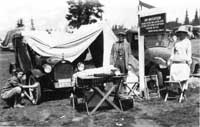 Mr. and Mrs. C. E. Lane and Hazel Emery relax with their auto tent at Mt. Rainier. ca 1923; Courtesy Southern Oregon Historical Society #15983
Mr. and Mrs. C. E. Lane and Hazel Emery relax with their auto tent at Mt. Rainier. ca 1923; Courtesy Southern Oregon Historical Society #15983
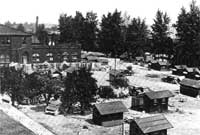 Although the private camps had started renting tent space, their proprietors soon realized that cabins with a few amenities attracted customers. Merrick’s Auto Camp in Medford. ca 1930; Courtesy Southern Oregon Historical Society #8940
Although the private camps had started renting tent space, their proprietors soon realized that cabins with a few amenities attracted customers. Merrick’s Auto Camp in Medford. ca 1930; Courtesy Southern Oregon Historical Society #8940
Although tent sales peaked between 1923 and 1924, many auto campers wanted to bring less camping equipment with them. Private camps attracted their share of the auto camping public because municipal camps were often crowded in the summer and had established limits on how long a tourist could stay. Although the private camps had started by renting tent space, their proprietors soon realized that cabins with a few amenities attracted customers. Cabins appeared in the Grants Pass and Ashland municipal camps by 1925, but by this time these operations had to compete with a number of private camps which sprouted along the newly numbered and paved highways.
The Redwood Highway connected Grants Pass with Crescent City in 1926, and anew route to Crater Lake from Medford was completed in 1927. These new roads and an improved Pacific Highway between Drain and Wolf Creek (which had been described in 1917 by Sunset Magazine as rough at all times and impassable in wet weather) allowed entrepreneurs to build camps with cabins at strategic points to lure the long-distance tourist. Since a cabin could be built for two hundred dollars or less, an owner’s investment could be paid off in a season or two. [9]
Whether the commercial camps were located in the vicinity of a town or on the highway many miles from a business district, the cabins tended to be arranged in a row parallel or perpendicular to the highway. [10] One of the few differences between city and rural commercial camps was that the latter more often included a gas station and/or store as part of the operation. During this period, “kitchenettes” were often provided in the cabin, but showers and toilets could be found in a central bathhouse. [11]
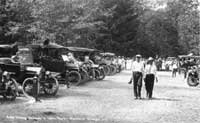 Lithia Park’s grounds were well used if the cars lined up here are any indication. Lithia Park auto camp grounds in Ashland, July 1931
Lithia Park’s grounds were well used if the cars lined up here are any indication. Lithia Park auto camp grounds in Ashland, July 1931
Courtesy Southern Oregon Historical Society #15985
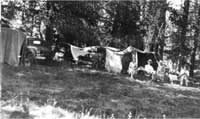 Left to right: Minnie Lane, Mr. and Mrs. Pernell Whitmore, Jessie Stone holding “Skippy” and Clarence Lane holding “Patsy” all camping at Diamond Lake. July 1931;Courtesy Southern Oregon Historical Society #15984
Left to right: Minnie Lane, Mr. and Mrs. Pernell Whitmore, Jessie Stone holding “Skippy” and Clarence Lane holding “Patsy” all camping at Diamond Lake. July 1931;Courtesy Southern Oregon Historical Society #15984
The first U.S. Forest Service campground was established in 1915 (along Eagle Creek in the Columbia River Gorge) and their number nationwide grew to fifteen hundred by 1923. [12] These campgrounds soon became an important component to outdoor recreation in the Pacific Northwest because over one-third of the region was national forest. Forest Service camp sites consisted of parking space for a car, a level area for tents, and a picnic table. The campground’s community pump provided drinking water, and one or two pit toilets served as sanitation. Like the early municipal camps, there was no charge for use of the facilities.
By 1935, auto camping widened to include what were originally called “trailer houses.” Trailers allowed the motorist to literally carry a dwelling to a camp site. Their appearance generally coincided with the development of cottage courts and motor inns, so that the modern range of accommodation for travelers was clearly discernible in 1940.
Availability of funds and labor for campground development through the Civilian Conservation Corps (CCC) program coincided with the trailer’s increasing popularity. Some camp sites were modified to accommodate this new type of auto camping despite a protest from one prominent campground designer stating that trailers were detrimental to “the camp spirit,” as contrasted with city, and town life. [13]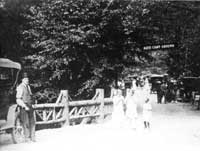 Lithia Park attracted tourists with amenities like mineral water, a community house with gas stoves, a nearby grocery store, and even a laundry wagon. ca 1916
Lithia Park attracted tourists with amenities like mineral water, a community house with gas stoves, a nearby grocery store, and even a laundry wagon. ca 1916
Courtesy Southern Oregon Historical Society #15987
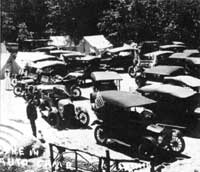 People flocked to the auto campground for the dedication of Lithia Park in Ashland, July 1916
People flocked to the auto campground for the dedication of Lithia Park in Ashland, July 1916
Courtesy Southern Oregon Historical Society #15986
Nevertheless, a number of parking spurs to accommodate trailers were eventually placed in many of the region’s Forest Service campgrounds. Few of the conversions were as dramatic as the metamorphosis of the Sucker Creek Forest Camp, located near Milepost 12 of the Oregon Caves Highway. A nearby CCC camp began work in late 1934 to make the campground suitable for trailers because of the gradient of the road beyond that point. It was renamed “Grayback Campground,” and the CCC began to construct new campsites which had larger vehicle parking space. Other projects there included a massive landscaping program to remove traces of the old campground; new fireplaces: and construction of a community building like those in the municipal auto camps.
Commercial use of the word “camp” declined in the late 1930s, especially when the proprietor’s aim was to cater to business travelers. Older cabin camps were increasingly left to the working class or itinerants, except in resort areas. Their image slid further after a well-publicized magazine article in 1940 labeled the majority of auto camps as havens for fugitives, prostitutes, and drug addicts. [14]
Auto camps are still well represented along highways throughout the Pacific Northwest. A few of them have been documented in county surveys of properties potentially eligible for the National Register of Historic Places, but they continue to disappear due to deterioration and changing uses. Many of the losses can be attributed to the failure of property owners and county officials to recognize auto camps as potentially significant historic resources.
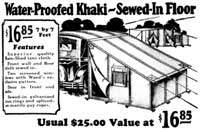 Camping enthusiasts could find auto tents, like this one, in their Montgomery Ward catalog, 1929
Camping enthusiasts could find auto tents, like this one, in their Montgomery Ward catalog, 1929
Three surveys conducted since 1976 identified eleven camps located in the two southwest Oregon counties as possibly significant historic properties. Five of these are located in Jackson County with the remainder in Josephine County. In contrast to the inns and hotels which preceded them, there has been comparatively little effort expended to preserve significant examples of this type of travelers’ accommodation. The lack of appreciation for how the automobile forever changed the region’s transportation infrastructure during the quarter century before 1940 is one reason. Another difficulty is an inability to identify auto camps and how they evolved from the first free municipal campgrounds in 1915, to the motor hotels (or “motel”) by the end of World War I. The remaining auto camps in local areas will have little chance to avoid eventual obliteration if their importance remains unknown and nothing is done to put them into context with the regional pattern of development.
Some auto camps in southwest Oregon might qualify for listing on the National Register because they meet Criterion A. This is where property is associated with processes that have been significant parts of “broad patterns” of national, state, or local history. They might also qualify under Criterion C, where a property is a good example of a particular kind of architectural style, or if it represents a significant and distinguishable entity whose components may lack individual distinction (such as a group of cabins that form a district). A camp must also meet a seven-way test for integrity of location, design, setting, materials, workmanship, feeling, and association. The tests for integrity are intended to disqualify those properties compromised by unsympathetic alterations.
Camping was inexpensive and many vacation destinations offered no other type of accommodation. ca 1927
Courtesy Southern Oregon Historical Society #15243
The National Register is virtually the only means of preserving significant examples of auto camps in southwest Oregon. The Union Creek Resort is the only auto camp in Jackson County already listed on the National Register at this writing. No auto camps have been listed in Josephine County.
Steven Mark is a historian who lives in Fort Klamath.
ENDNOTES
-
A Warren James Belasco, Americans on the Road: From Auto Camps to Motel, 1910-1945, (Cambridge, MA: MIT Press, 1979) p. 139.
-
Ashland Parks file, SOHS Medford.
-
“America Takes to the Motor Court,” Business Week 563, 15 Jun 1940, p. 19.
-
Warren James Belasco, p.77.
-
Grants Pass Courier, 16 May 1915.
-
“A Bit of Old Ashland,” papers and interviews by eighth graders of Ashland Junior High School, 1978, compiled by Marjorie Lininger, P.S.
-
Warren James Belasco, p.78.
-
Earl Chapman May. “The Argonauts of the Automobile,” Saturday Evening Post197:6,9 Aug 1924, p.89.
-
Staff of Popular Science Monthly, How to Build Cabins, Lodges, and Bungalows,(New York: Grosset & Dunlap, 1934) p.14.
-
Norman Hayner, “Auto Camps in the Evergreen Playground” Social Forces 9:1 Oct 1930, p. 256-266.
-
Popular Science Monthly. op cit., p. 210-214.
-
William C. Tweed, Recreation Site Planning and Improvement in National Forests, 1891-1942, (Publication FS-354, Government Printing Office. Washington, DC, 1980) pp. 4-5.
-
E.P. Meineche, “The Trailer Menace-A voice From the Past,” Journal of Forestry,70:5, May.
-
J. Edgar Hoover, “Camps of Crime,” American Magazine 129:2 Feb 1940, pp.14-15,130-132.
This article first appeared in Southern Oregon Heritage, 1998, Vol. 3 No. 4

